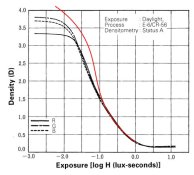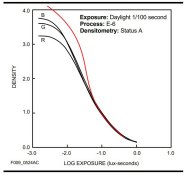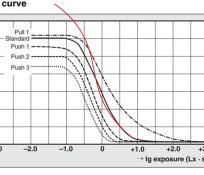Hello Klaus,
This is also a good way to roughly estimate the maximum density:
Hold the black slide directly in front of your eye and then look into a light source (desk lamp) for about 30...60 seconds.
At a density of about 3.00 you can just see the light source but not the surrounding area.
I can confirm this. This "rule of thumb" works relatively well.
And what can also be seen this way:
You can only see through the transparency (slide) if you have it directly in front of your eye. The greater the distance to the transparency, the denser and deeper the black looks, and it is then impossible to look through it.
The light intensity is decreasing disproportionately high with increasing distance ("Abstandsgesetz", distance law, I ~ 1/r²). And that is also one of the reasons why a Dmax of 3 on a transparency is enough for having real blacks on the screen, viewed at normal viewing distances. You are not looking at the projected picture on the screen from just some centimeters, but from normally 3-5 meters distance in a standard living room.
My process is optimized for slide projection on a screen in the best possible quality.
To achieve a good black (zone 0) on the screen under good projection conditions, you need a slide with a maximum density oft about 4.00.
Well, that is your personal preference, but not a general physical requirement.
Therefore I have partly to disagree here with you, as such a high Dmax is not always necessary to have real, deep, textureless blacks on the screen with normal viewing distances. Concerning light intensity and brillance I am using the best transparency projection technology which is available: A 250W Leica Pradovit PC with the improved condensor system (20% more light), and as screen the Da-Lite with HP surface, which is the most brillant surface possible, delivering outstanding projection quality.
And I have a four-digit number of BW transparencies here with Dmax values in the range of 2.8 - 3.3 (dependent on the film), which all deliver sufficient deep blacks in the projection on HP screen.
There is a simple rule here: If you have a real black in the original subject, you also get it on screen with normal viewing distances. Physics, the distance law / Abstandsgesetz is working here to our benefit.
And none of my viewers of my BW transparencies from that Dmax group has ever complained about the blacks. Just the opposite, all were impressed.
Having a higher Dmax is of course nice (like those I have from your and another process), but it is not an absolute necessity to have that. Otherwise Agfa Scala and the Foma process would not have had so much satisfied users over all the years.
From my experience with diferrent BW transparency films and different processes I recommend an a bit more relaxed attitude concerning Dmax. It should not be a "fetish", as the overall quality of a transparency is determined by several factors, and not only by one.
And Klaus, an extremely high Dmax is worthless if the slides are yellowing over the time......you know what I mean


.
Best regards,
Henning









 .
. . Try different films and processes, and see, what you like best.
. Try different films and processes, and see, what you like best. Have a great day.
Have a great day.